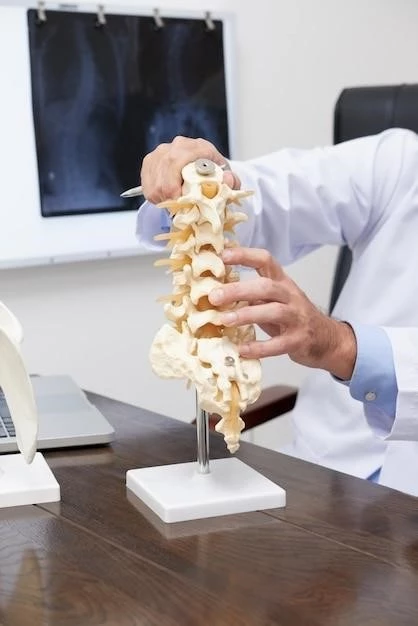Introduction
Vertebral fusion posterior lumbosacral blepharoptosis is characterized by congenital ptosis and fusion of the lumbosacral vertebrae. Learn more below.
Definition of Vertebral Fusion Posterior Lumbosacral Blepharoptosis
Vertebral fusion posterior lumbosacral blepharoptosis is a rare syndrome characterized by congenital ptosis and fusion of the lumbosacral vertebrae. This condition involves the bony fusion of the posterior part of the L5 vertebral body with the sacrum‚ leading to a drooping upper eyelid position. Research has indicated familial cases of this syndrome‚ highlighting its genetic component. Diagnosis often involves clinical evaluation‚ imaging studies‚ and genetic testing to confirm the presence of vertebral fusion and blepharoptosis.

Clinical Presentation
Signs of Vertebral Fusion Posterior Lumbosacral Blepharoptosis include congenital ptosis and fusion of lumbosacral vertebrae. Learn more below.
Signs and Symptoms
Vertebral fusion posterior lumbosacral blepharoptosis presents with congenital ptosis‚ where the upper eyelid droops and may cover a portion of the eye. The syndrome also includes the fusion of the lumbosacral vertebrae‚ particularly the bony fusion of the posterior part of the L5 vertebral body with the sacrum. Individuals with this condition may experience tightness in the heel cords and elevated serum lactic dehydrogenase activity‚ further indicating the presence of the syndrome.
Diagnosis
Diagnosis of Vertebral Fusion Posterior Lumbosacral Blepharoptosis involves clinical assessment‚ imaging studies‚ and genetic testing to confirm the presence of congenital ptosis and fusion of the lumbosacral vertebrae. Learn more below.
Diagnostic Tests
Diagnostic tests for Vertebral Fusion Posterior Lumbosacral Blepharoptosis typically include a thorough clinical evaluation‚ imaging studies such as X-rays to identify vertebral fusion‚ as well as genetic testing to confirm the presence of this rare syndrome. Additionally‚ routine laboratory tests may be conducted to assess serum lactic dehydrogenase activity and confirm the diagnosis. Physicians may also perform specific neurological examinations and assessments to understand the extent and impact of the vertebral fusion and blepharoptosis on an individual’s health.
Etiology
Etiology of Vertebral Fusion Posterior Lumbosacral Blepharoptosis involves genetic factors contributing to the rare syndrome characterized by congenital ptosis and fusion of the lumbosacral vertebrae. Learn more below.
Cause of Vertebral Fusion Posterior Lumbosacral Blepharoptosis
The cause of Vertebral Fusion Posterior Lumbosacral Blepharoptosis is primarily attributed to genetic factors leading to the rare syndrome characterized by congenital ptosis and fusion of the lumbosacral vertebrae. This condition involves bony fusion of the posterior part of the L5 vertebral body with the sacrum‚ resulting in the distinctive clinical features observed in affected individuals. The genetic component plays a crucial role in the manifestation of this syndrome‚ as evidenced by familial cases that have been reported. Further research is ongoing to elucidate the underlying genetic mechanisms contributing to this rare condition.
Pathophysiology
Posterior fusion of lumbosacral vertebrae-blepharoptosis syndrome involves bony fusion of the L5 vertebral body with the sacrum‚ leading to congenital ptosis. Learn more below.
Understanding the Mechanism of the Disease
The mechanism of Vertebral Fusion Posterior Lumbosacral Blepharoptosis involves the bony fusion of the posterior part of the L5 vertebral body with the sacrum‚ resulting in congenital ptosis. This rare syndrome is characterized by the fusion of lumbosacral vertebrae‚ leading to distinct clinical manifestations observed in affected individuals. Specialists have conducted research and identified genetic factors as contributors to this syndrome‚ highlighting the complexity of the disease mechanism.
Details regarding the prevalence and incidence rates of Vertebral Fusion Posterior Lumbosacral Blepharoptosis are outlined in the available research. Explore more below.
Epidemiology
Details regarding the prevalence and incidence rates of Vertebral Fusion Posterior Lumbosacral Blepharoptosis are outlined in the available research. Explore more below.
Management
Treatment Approaches for Vertebral Fusion Posterior Lumbosacral Blepharoptosis may involve a multidisciplinary approach incorporating genetic testing and surgical interventions. Discover more below.
Prevalence and Incidence Rates
The rare syndrome known as Vertebral Fusion Posterior Lumbosacral Blepharoptosis has been reported in familial cases‚ with documented instances in a mother and her daughters. Research indicates a genetic component in the manifestation of this condition‚ emphasizing the need for further investigation to determine the prevalence and incidence rates accurately in the population.
Prognosis
The prognosis of Vertebral Fusion Posterior Lumbosacral Blepharoptosis may vary based on individual cases and the extent of fusion and associated symptoms. Explore further below.
Outcomes and Long-Term Effects
The long-term effects of Vertebral Fusion Posterior Lumbosacral Blepharoptosis can vary depending on each individual case. While surgical interventions may alleviate symptoms associated with the syndrome‚ ongoing management is often necessary to address any lingering issues. Further research is crucial to better understand the prognosis and potential outcomes of individuals affected by this rare condition.
Research and Studies
Experts have conducted extensive research on Posterior Fusion of Lumbosacral Vertebrae-Blepharoptosis Syndrome‚ focusing on genetic factors‚ clinical manifestations‚ and potential treatment modalities. Learn more below.
Notable Research Findings
Specialists have conducted research on Posterior Fusion of Lumbosacral Vertebrae-Blepharoptosis Syndrome‚ focusing on genetic factors‚ clinical manifestations‚ and potential treatment modalities. These experts are considered knowledgeable about the disease due to their involvement in grants‚ articles‚ clinical trials‚ and related organizations.

Support Resources
Community Groups and Advocacy Organizations offer support and information for individuals and families affected by Vertebral Fusion Posterior Lumbosacral Blepharoptosis. Discover more below.
Community Groups and Advocacy Organizations
Community groups and advocacy organizations offer support and information to individuals and families affected by Vertebral Fusion Posterior Lumbosacral Blepharoptosis. By providing a platform for sharing experiences and resources‚ these groups help navigate the challenges associated with this rare syndrome. Additionally‚ they contribute to raising awareness and promoting research efforts to enhance the understanding and management of the condition.
Conclusion
In conclusion‚ Vertebral Fusion Posterior Lumbosacral Blepharoptosis is a rare syndrome characterized by the fusion of lumbosacral vertebrae and congenital ptosis. Research and specialized care play crucial roles in managing this condition effectively.
Summary of Vertebral Fusion Posterior Lumbosacral Blepharoptosis
Posterior fusion of lumbosacral vertebrae-blepharoptosis syndrome is a rare condition characterized by congenital ptosis and fusion of the lumbosacral vertebrae. Research has focused on genetic factors‚ clinical manifestations‚ and potential treatments for this syndrome‚ with specialized care playing a vital role in managing the disease effectively. Further investigations are ongoing to enhance understanding and management strategies for individuals affected by this unique syndrome.
